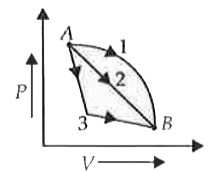An ideal gas of mass m in a state A goes to another state B via three different processes as shown in fig. If and denote the heat absorbed by the gas along the three paths, then:

]
The correct Answer is:A
is same for all the paths and W is max, for path 3.
Topper's Solved these Questions
- THERMODYNAMICS BOOK - DISHA PUBLICATIONCHAPTER - THERMODYNAMICS EXERCISE - EXERCISE-1 : CONCEPT BUILDER (Topic-3 CARNOT ENGINE, REFIGERATOR AND SECOND LAW OF THERMODYNAMICS)
15 Videos
- THERMODYNAMICS BOOK - DISHA PUBLICATIONCHAPTER - THERMODYNAMICS EXERCISE - EXERCISE -2 : CONCEPT APPLICATOR
29 Videos
- THERMODYNAMICS BOOK - DISHA PUBLICATIONCHAPTER - THERMODYNAMICS EXERCISE - EXERCISE-1 : CONCEPT BUILDER (Topic- ZEROTH LOW AND FIRST LAW OF THERMODYNAMICS)
11 Videos
- THERMAL PROPERTIES OF MATTER BOOK - DISHA PUBLICATIONCHAPTER - THERMAL PROPERTIES OF MATTER EXERCISE - Exercise-2 (Concept Applicator)
28 Videos
- WAVE OPTICSBOOK - DISHA PUBLICATIONCHAPTER - WAVE OPTICSEXERCISE - EXERCISE-2 : CONCEPT APPLICATOR
30 Videos
Similar Questions
An ideal gas goes from state A to state B via three different processes as indicated in the P-V diagram -

If Q1,Q2,Q3 indicate the heat absorbed by the gas along the three process and ΔU1,ΔU2,ΔU3, indicate the change in internal energy along the three processes respectively, then -
View SolutionAn ideal gas is taken from state A to state B via three different processes as shown in the pressure volume(P−V) diagram. If Q1, Q2 &Q3 indicates the heat absorbed by the gas and ΔU1 , ΔU2 &ΔU3 indicate change in internal energy in three processes, then
_PHY_E05_030_Q01.png)
View Solution
Knowledge Check
An ideal gas goes from state A to state B via three different processes as indicated in the P-V diagram. If Q1,Q2,Q3 indicate the heat absorbed by the gas along the three processes and ΔU1,ΔU2,ΔU3 indicate the change in internal energy along the three processes respectively, then
 AQ1>Q2>Q3 and ΔU1=ΔU2=ΔU3BQ1>Q2>Q3 and ΔU1=ΔU2=ΔU3CQ1=Q2=Q3 and ΔU1>ΔU2>ΔU3DQ3>Q2>Q1 and ΔU1>ΔU2>ΔU3
AQ1>Q2>Q3 and ΔU1=ΔU2=ΔU3BQ1>Q2>Q3 and ΔU1=ΔU2=ΔU3CQ1=Q2=Q3 and ΔU1>ΔU2>ΔU3DQ3>Q2>Q1 and ΔU1>ΔU2>ΔU3An ideal gas goes from State A to state B via three different process as indicate in the P−V diagram.

If Q2,Q3 indicates the heat absorbed by the gas along the three processes and ΔU1,ΔU2,ΔU3 indicates the change in internal energy along the three processes respectively, thenAQ1>Q2>Q3 and ΔU1=δU2=ΔU3BQ3>Q2>Q1 and ΔU1=ΔU2=ΔU3CQ1=Q2=Q1 and ΔU1>ΔU2>ΔU3DQ3>Q2Q1 and ΔU1>ΔU2>ΔU3A given mass of a gas expands from the state A to the state B by three paths 1,2 and 3 as shown in the figure, If W1,W2 and W3 respectively be the work done by the gas along the three paths then
 AW1>W2>W3BW1<W2<W3CW1=W2=W3DW1<W2=W3
AW1>W2>W3BW1<W2<W3CW1=W2=W3DW1<W2=W3
A given mass of a gas expands from the state A to the state B by three paths 1,2 and 3 as shown in the figure, If W1,W2 and W3 respectively be the work done by the gas along the three paths then

View SolutionA givne mass of a gas expands from a state A to the state B by three paths 1, 2 and 3 as shown in T-V indicator diagram. If W1,W2 and W3 respectively be the work done by the gas along the three paths, then

View SolutionA given mass of gas expands from state A to state B by three paths 1, 2, and 3 as shown in the figure :

If w1,w2andw3 respectively, be the work done by the gas along three paths, then
View SolutionA givne mass of a gas expands from a state A to the state B by three paths 1, 2 and 3 as shown in T-V indicator diagram. If W1,W2 and W3 respectively be the work done by the gas along the three paths, then

View SolutionA given mass of a gas expands ffrom a state A to the state B by three paths 1,2
and 3 as shown in T-V indicator diagram. If W1,W2andW3 respectively be
the work done by the gas along the three paths, then
View Solution
